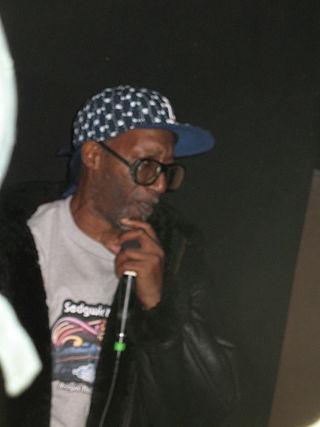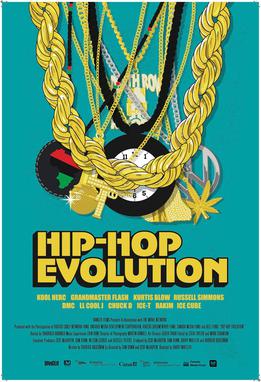The new school of hip hop was a movement in hip hop music, beginning in 1983–84 with the early records of Run–D.M.C., Whodini, and LL Cool J. Predominantly from Queens and Brooklyn, it was characterized by drum machine-led minimalism, often tinged with elements of rock; rapped taunts, boasts, and socio-political commentary; and aggressive, self-assertive delivery. In song and image, its artists projected a tough, cool, street b-boy attitude. These elements contrasted sharply with funk and disco, novelty hits, live bands, synthesizers, and party rhymes of artists prevalent in the early 1980s. Compared to their older hip hop counterparts, new school artists crafted more cohesive LPs and shorter songs more amenable to airplay. By 1986, their releases began to establish hip hop in the mainstream.

Turntablism is the art of manipulating sounds and creating new music, sound effects, mixes and other creative sounds and beats, typically by using two or more turntables and a cross fader-equipped DJ mixer. The mixer is plugged into a PA system and/or broadcasting equipment so that a wider audience can hear the turntablist's music. Turntablists typically manipulate records on a turntable by moving the record with their hand to cue the stylus to exact points on a record, and by touching or moving the platter or record to stop, slow down, speed up or, spin the record backwards, or moving the turntable platter back and forth, all while using a DJ mixer's crossfader control and the mixer's gain and equalization controls to adjust the sound and level of each turntable. Turntablists typically use two or more turntables and headphones to cue up desired start points on different records.

Beat Street is a 1984 American dance drama film featuring New York City hip hop culture of the early 1980s. Set in the South Bronx, the film follows the lives of a pair of brothers and their group of friends, all of whom are devoted to various elements of early hip hop culture, including breakdancing, DJing and graffiti.

Coke La Rock is an old-school rapper from New York City who is sometimes credited as being the first MC in the history of hip-hop.
In popular music, a break is an instrumental or percussion section during a song derived from or related to stop-time – being a "break" from the main parts of the song or piece. A break is usually interpolated between sections of a song, to provide a sense of anticipation, signal the start of a new section, or create variety in the arrangement.

Rappin' is a 1985 American film directed by Joel Silberg, written by Adam Friedman and Robert J. Litz, produced by Menahem Golan and Yoram Globus and starring Mario Van Peebles. The film is a sequel to Breakin' 2: Electric Boogaloo, and is also known as Breakdance 3. Although it features Ice-T, Rappin' has a plot unconnected to the previous two films and features different lead characters and locations. It is also considered to be a companion piece to the documentary Breakin' 'n' Enterin'.
Wendell Timothy Fite, also known as DJ Hurricane is an American hip hop DJ, producer and rapper. He is best known for his work with the Beastie Boys. He was a member of the groups Solo Sounds and The Afros and recorded three solo albums, featuring many well-known artists such as Xzibit, Public Enemy, Kool G Rap, Black Thought, Papoose and Talib Kweli.

Golden age hip hop refers to mainstream hip hop music created from the mid or mid-late 1980s to the early or early-mid 1990s, particularly by artists and musicians originating from the New York metropolitan area. A precursor to the new-school hip hop movement, it is characterized by its diversity, quality, innovation and influence on overall hip hop after the genre's emergence and establishment in the old-school era, and is associated with the development and eventual mainstream success of hip hop. There were various types of subject matter, while the music was experimental and the sampling from old records was eclectic.
Funky 4 + 1 was an American hip hop group from The Bronx, New York, composed of Jazzy Jeff, Sha-Rock, D.J. Breakout, Guy Williams, Keith Keith, The Voice of K.K. and Rodney Stone. The latter two members also performed together as the duo Double Trouble, notably in the film Wild Style. They were the first hip hop group to receive a record deal, as well as the first to perform live on national television. The group was also notable for being the first to have a woman MC, Sha-Rock.

"Renegades of Funk" is a song written by Afrika Bambaataa, Arthur Baker, John Miller & John Robie and recorded by Afrika Bambaataa & Soulsonic Force. Released in 1983 as a single on the Tommy Boy label, it was also included on the 1986 album Planet Rock: The Album. The song is an eclectic fusion of electronic music and heavy percussion, with politically fused hip hop lyrics that draw a connection between past revolutionaries and bohemians to present-day street artists. It was produced and mixed by Arthur Baker and John Robie. Mastering was by Herb Powers Jr..

Clive Campbell, better known by his stage name DJ Kool Herc, is a Jamaican American DJ who is credited with being one of the founders of hip hop music in the Bronx, New York City, in 1973. Nicknamed the Father of Hip-Hop, Campbell began playing hard funk records of the sort typified by James Brown.
Hip-hop or hip hop, also known as rap, and formerly known as disco rap, is a genre of popular music that originated in the early 1970s by African Americans and Caribbean immigrants in the Bronx, a borough of New York City. Hip-hop music originated as an anti-drug and anti-violence genre consisting of stylized rhythmic music that often accompanies rapping, a rhythmic delivery of poetic speech. According to the professor Asante of African American studies at Temple University, "hip hop is something that blacks can unequivocally claim as their own". The music developed as part of the broader hip hop culture, a subculture defined by four key stylistic elements: MCing/rapping, DJing/scratching with turntables, breakdancing, and graffiti art. While often used to refer solely to rapping and rap music, "hip hop" more properly denotes the practice of the entire subculture. The term hip hop music is sometimes used synonymously with the term rap music, though rapping is not a required component of hip hop music; the genre may also incorporate other elements of the culture, including DJing, turntablism, scratching, beatboxing, and instrumental tracks.

Dennis P. Eichhorn was an American writer, best known for his adult-oriented autobiographical comic book series Real Stuff. His stories, often involving, sex, drugs, and alcohol, have been compared to those of Jack Kerouac, Ken Kesey, and Charles Bukowski.

1520 Sedgwick Avenue is a 102-unit apartment building in the Morris Heights neighborhood of the Bronx in New York City. Described in The New York Times as a long-time "haven for working class families", it has been historically accepted as the birthplace of hip hop.

"Sucker M.C.'s" is a song by American hip hop group Run-D.M.C. It was first released in 1983 as B-side to "It's Like That". The two-sided release marked the start of Run-D.M.C.'s career as their first single, and it is widely regarded as ushering in a new school of hip hop artists with a street image and an abrasive, minimalist sound that marked them out from their predecessors. Both tracks were collected on the trio's self-titled debut album in 1984. WBAU was the first station to play the two songs.

Edward R. Piskor Jr. was an American alternative comics cartoonist. Piskor was known primarily for his work on Hip Hop Family Tree, X-Men: Grand Design, and the Red Room trilogy. Piskor also co-hosted the YouTube channel Cartoonist Kayfabe with fellow Pittsburgh native cartoonist Jim Rugg. In March 2024, Piskor was accused via social media of sexual misconduct. Piskor died on April 1, 2024, at the age of 41, hours after posting a suicide note via social media, defending himself against the allegations leveled against him.

Run-DMC was an American hip hop group from Hollis, Queens, New York City, formed in 1983 by Joseph Simmons, Darryl McDaniels, and Jason Mizell. Run-DMC is regarded as one of the most influential acts in the history of hip hop culture and especially one of the most famous hip hop acts of the 1980s. Along with Beastie Boys, LL Cool J, DJ Jazzy Jeff & the Fresh Prince, and Public Enemy, the group pioneered new-school hip hop music and helped usher in the golden age of hip hop. The group was among the first to highlight the importance of the MC and DJ relationship.
Sharon Green, also known as MC Sha-Rock, is considered the "first female rapper" or emcee. Born in Wilmington, North Carolina, she grew up in the South Bronx, New York City during the earliest years of hip hop culture and rap music. Within the hip-hop community she has been referred to as the "Mother of the Mic" signifying her role as a prominent female figure among the early rappers. As a member of the first hip-hop crew to appear on national television, known as the Funky 4 + 1, her style of delivering raps on early mixtapes influenced notable rappers like MC Lyte and DMC of Run-DMC. McDaniels cited Green as a significant influence on the style of rapping associated with the pioneering group.

Hip-Hop Evolution is a Canadian music documentary television series that originally aired on HBO Canada in 2016. Hosted by Juno Award-winning artist Shad, the series profiles the history of hip-hop music through interviews with many of the genre's leading cultural figures. The series is produced by Darby Wheeler, Rodrigo Bascuñán, Russell Peters, Scot McFadyen, Sam Dunn and Nelson George. It won the 2016 Peabody Award, and the 2017 International Emmy Award for Best Arts Programming.

Contact High: A Visual History of Hip-Hop is a 2018 photography book created and written by Vikki Tobak and ongoing exhibition series. The volume features contact prints from analog photography sessions of hip hop artists during roughly forty-years, from the beginnings of the genre in the late 1970s until the late 2000s.














